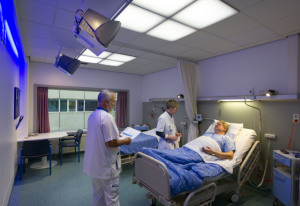by
Brendon Nafziger, DOTmed News Associate Editor | January 23, 2012

Philips' HealWell lighting system (Credit: Philips)
A new hospital lighting system that mimics natural daylight and the daily rhythms of light intensity could help patients rest easier.
Royal Philips Electronics, the world's biggest maker of light bulbs and other lighting stuff, is launching its HealWell lighting system for Middle East markets this week at the
Arab Health conference in Dubai.
The centerpiece of the system is a set of fluorescent lights on the ceiling, which sort of resembles a skylight. The light pouring from the fixture is meant to mimic, in its changing luminosity, the course of the sun through a sunny day, starting out very bright in the morning and diminishing in intensity in the evening. The light's "temperature" rises throughout the day, too, starting off cold in the morning but becoming warmer later on.
Rooms with HealWell are several orders of magnitude brighter than your typical hospital set-up, according to Philips. Illuminance is generally measured in lux, an International Standard unit. Most hospital rooms are 100 lux, with maybe 300 lux for the examination bed. Your office is probably around 500 lux, but even that is rather dim when compared with natural daylight.
"That's far below what you experience outside even on a cloudy day," Gaby Meekes, a global marketing manager with Philips, told DOTmed News. A cloudy day is about 2,000 to 5,000 lux, she said. But a sunny day can range anywhere from 10,000 to over 100,000 lux.
The Philips HealWell lighting system is set around 2,000 lux in the morning for a couple of hours, and 100-300 throughout the rest of the day. Meekes said that based on research they had done, they thought it important for people to receive at least two hours at 2,000 lux in the morning.
Mood improver
Why is brighter better? According to Philips, research suggests that exposure to the proper natural rhythm of light could help you sleep better and improve your mood. This is especially important for patients in hospitals, nursing homes or other places where they basically never go outdoors, Philips said.
"As human beings, we used to live outside a lot. In our modern society we spend so much time indoors; there are studies that show 50 to 80 percent of our time is spent in offices, shops or our homes, where the light levels are low even if you have windows," Meekes said.
In fact, Meekes said in their studies at hospitals, they found that having large windows didn't help meaningfully raise your light exposure unless you were within one meter of the window.
